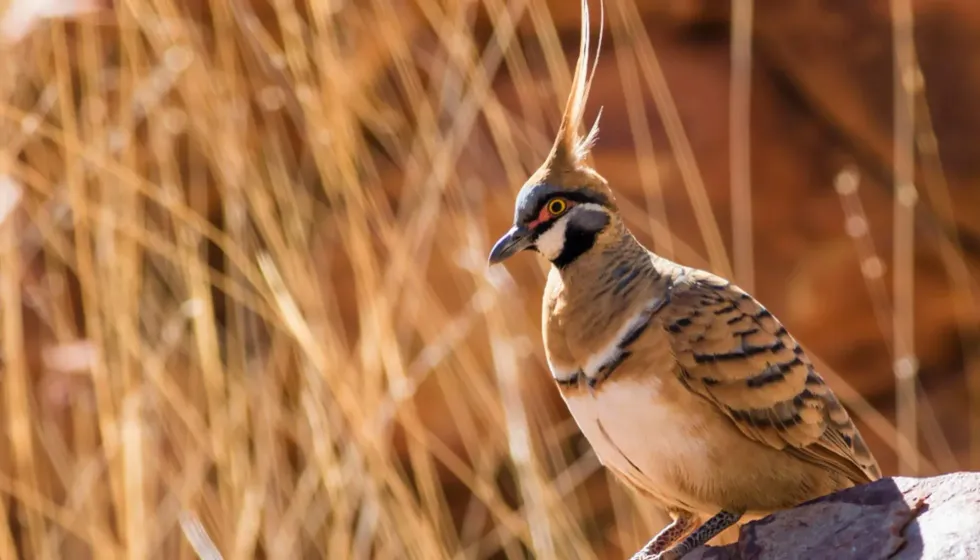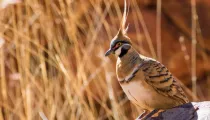The spinifex pigeon (Geophaps plumifera) is part of the genus Geophaps and part of the family Columbidae. These birds are also known by the names of plumed pigeons and gannaway pigeons and are one of four endemic bird species of the genus in Australia.
The current taxonomy of spinifex pigeons classifies the birds into three subspecies: a central eastern white-bellied subspecies, the eastern spinifex pigeon (Geophaps plumifera leucogaster); a north western white-bellied subspecies, the north western spinifex pigeon (Geophaps plumifera plumifera); and a brown bellied western subspecies, the Pilbara spinifex pigeon (Geophaps plumifera ferruginea).
A gannaway pigeon bird of a different genus also exists with the name of Pannawonica gannaway pigeon (Gannawasa pigeonous).
The western crowned pigeon and the pheasant pigeon are also part of the family Columbidae. To know some interesting facts about these birds, why not take a look at these articles too?
Spinifex Pigeon Interesting Facts
What type of animal is a spinifex pigeon?
Spinifex pigeons are a type of pigeon found only in Australia.
What class of animal does a spinifex pigeon belong to?
These bird species falls under the class of Aves in the kingdom of Animalia. This species is part of the family of Columbidae.
How many spinifex pigeons are there in the world?
The population size of this bird species is unknown. The trend shows that the population is quite stable for these birds which have an extensive range spread across 1,389,967.8 sq mi (3,600,000 sq km).
Where does a spinifex pigeon live?
According to the current taxonomy, this bird species is classified into three subspecies. The range of these birds is quite extensive.
North western spinifex pigeons are found in the arid areas of northern and northwestern Australia. The central eastern subspecies called eastern spinifex pigeons can be found the northwest part of Queensland and central Australia. Pilbara spinifex pigeons are found in Pilbara in western Australia.
What is a spinifex pigeon's habitat?
This bird species is found in arid and semi-arid areas of northern and central Australia. They prefer stony areas on hills full of rocks and love mountainous terrain, gorges, and dry creek beds with rocks.
These birds are found mostly in areas containing hummock-forming grass, especially among spinifex grasses. In some areas, they are also found among other types of sparse grasslands.
The search for these bird species can lead to areas where there is extreme fluctuation in temperature and aridity. Spinifex pigeons do not travel long distances in search of water.
Who do spinifex pigeons live with?
These birds are mostly found in pairs and small groups. Groups are usually of four to 20 birds. If all seasonal conditions are met, large flocks of around 400 birds have also been seen.
How long does a spinifex pigeon live?
Pigeons, in general, live up to the age of 10-15 years. An exact description of the lifespan of a spinifex pigeon is not available.
How do they reproduce?
The breeding season is in spring and early summer, that is, from August to January. These pigeons normally nest on the ground. Females are known to lay two eggs in a breeding season and the eggs are creamy white in color.
Both parents share nest duties and incubation of the eggs is carried out by both for 16-18 days. After the eggs hatch, the chicks need seven to nine days to learn to run. They leave the nest after 11 days.
What is their conservation status?
The conservation status of this bird species has been categorized as Least Concern by the IUCN Red List. These birds are found extensively in their habitats in the northern, central, eastern, and mostly in the west part of Australia. However, these ground-feeding birds are sometimes affected by habitat degradation and predation by other animals.
Spinifex Pigeon Fun Facts
What do spinifex pigeons look like?
Spinifex pigeons are small, plumb, and terrestrial birds. Any description of these birds starts with their rufous-brown coloration and the thin, black bars on their wings and back. Their bill is black in color.
They have a gray forehead and the sides of their crown along with their ear coverts are also gray. Their face has a bright red coloration, like a mask, which is bordered by a black supercilium and mustache stripe.
Their throat is colored black and there is a white band that goes from their chin to the back of their eye.
Their legs and feet are gray. A white stripe can also be seen on their chest.
Most subspecies have white bellies, while the Pilbara spinifex pigeon has a brown belly. Males are a little bigger than females. Their erect crest is not visible while in flight.
How cute are they?
With their mohawk-like feather, spinifex pigeons are extremely popular and are considered pretty cute.
How do they communicate?
Spinifex pigeons make a 'cooo-woo' sound in a repeated fashion with a high-pitched voice. During breeding, males are known to make a short grunting 'coo' sound. These birds also have a head-shaking display which is probably a way to communicate with each other.
How big is a spinifex pigeon?
Spinifex pigeons have a mean body length of 7.9-9.3 in (20-23.5 cm). Their wingspan is 11.8-13.8 in (30-35 cm). If we compare this species of pigeons with the Nicobar pigeons found in Australia, the latter has a range of length that goes up to 21-23 in (53.3-58.4 cm).
How fast can a spinifex pigeon fly?
The speed of flight of spinifex pigeons is unknown.
How much does a spinifex pigeon weigh?
Spinifex pigeons have a range of weight that varies from 0.176-0.242 lb (80-110 g). In comparison, the weight of the German nun pigeon has a range of up to 0.79 lb (358.7 g).
What are their male and female names of the species?
Males and females are not given different names.
What would you call a baby spinifex pigeon?
A baby spinifex pigeon is called a chick.
What do they eat?
The diet of these birds includes seeds of grass and herbs, mainly of spinifex (triodia). They also forage on leaves and need plenty of water. Spinifex pigeons have a diet that includes various invertebrates too, such as worms, and ants. These birds have a lot of predators including falcons, foxes, ferrets, and snakes.
Are they dangerous?
They are not known to be dangerous at all.
Would they make a good pet?
They are not usually kept as pets, however, they can be seen in many national parks where they are kept as protected animals.
Did you know...
The search for these birds is restricted to a huge population in central and western Australia with a fraction of the population in the north and eastern parts of the country.
The special wing this bird species has, in the form of a mohawk-like structure, helps them make a loud whistling sound. This is done to lure predators towards these birds in flight and sway their attention away from birds on the ground.
This practice is like a warning call to any birds on the ground and to all other pigeons nearby.
The species is endemic to Australia.
Are there wood pigeons in Australia?
The wood pigeon is mostly found in European and Asian countries. There is no information on their range in the Australian continent.
Does the spinifex pigeon migrate?
They are not known to migrate. They may however shift between flocks. They usually stay near permanent water bodies all the time.
Here at Kidadl, we have carefully created lots of interesting family-friendly animal facts for everyone to discover! Learn more about some other birds from our sugarbird facts and lineated woodpecker facts pages.
You can even occupy yourself at home by coloring in one of our free printable spinifex pigeon coloring pages.









